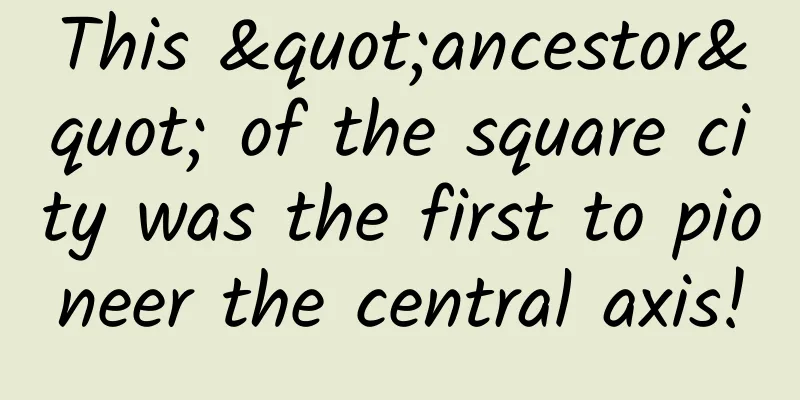This "ancestor" of the square city was the first to pioneer the central axis!

|
The ruins of the ancient city of Pingliangtai. Photo courtesy of Zhoukou Pingliangtai Ruins Museum Recently, the "Beijing Central Axis" was successfully listed as a World Heritage Site, and the whole country celebrated. Beijing's 7.8-kilometer-long central axis, which connects the past and the present, has become the "top stream" of people's attention. As the epitome of ancient Chinese urban planning and construction skills, Beijing's central axis symmetry, square rules, and strict planning of the city pattern show the long-term continuity and vitality of China's traditional capital planning concept, and embody the Chinese people's imagination of an ideal city. So, when did this concept of square and regular architectural layout with a prominent central axis originate? And where is the source? In order to find the answer to the question, the reporter recently visited the Pingliangtai Ancient City Ruins in Huaiyang District, Zhoukou City, traveling through the long river of history and exploring the veins of civilization. A square city Go southeast from Huaiyang City, across the vast Chenghu Lake, and walk about 4 kilometers to the ruins of Pingliangtai Ancient City. In midsummer, Pingliangtai is full of cicadas and lush vegetation, showing its simplicity and grandeur under the warm sunshine. Pingliangtai is a well-preserved ancient city of Longshan culture, commonly known as "Pingliang Tomb" or "Grain Storage Platform". It is an ancient city of Wanqiu, which is recorded in history as "the ruins of Taihao" and "the former capital of Shennong". It has a history of more than 4,600 years and is a high-level prehistoric city site. The discovery of Pingliangtai Ancient City is of great value and significance to the study of the origin of Chinese civilization, the origin of the country, the emergence of cities, the formation of early slavery, the differentiation of social division of labor, and the development history of bronze smelting technology. In 1988, the Pingliangtai Ancient City Ruins were announced by the State Council as the "third batch of national key cultural relics protection units"; in 1990, it was rated as one of the "Top Ten Archaeological Discoveries in Henan Province in the 20th Century"; in 2020, it was selected as one of the "Top Ten Archaeological Discoveries in China in 2019". Pingliangtai Ancient City is square in plan, 6 degrees north by east, and covers an area of more than 50,000 square meters. It is the earliest square city discovered in my country with strict planning. It can be said to be the ancestor of the square city. Influenced by the idea of "round sky and square earth", the square city is the traditional form of Chinese cities. Therefore, Pingliangtai Ancient City has become a model of the standard shape of cities for future generations. In the ancient city of Pingliangtai, there is a road about six or seven meters wide, running through the north and south. The two ends correspond to the north and south city gates respectively. It is located in the middle and symmetrical on both sides. It is a veritable central axis. This central axis is also the earliest physical central axis of a city discovered in my country. It has found the origin of coordinates for tracing the connotation and characteristics of the ancient Chinese city layout, and also provided important archaeological evidence for the successful application of Beijing's central axis for World Heritage status. The Pingliangtai ancient city ruins have the characteristics of a square and regular plane and internal central axis symmetry, which have been passed down to this day. They carry the Chinese people's aesthetic pursuit and practical needs for architecture. They are undoubtedly the earliest source of ancient Chinese urban planning ideas and have milestone significance in the history of Chinese urban development. Many "firsts" in urban construction originated here More than 4,600 years ago, the ancestors of the ancient city of Pingliangtai had pioneered the city-building technology of small-scale pile-building. The remaining height of the ancient city wall of Pingliangtai is 3-5 meters, the base width is about 13 meters, and the top width is 8-10 meters. Such a tall and magnificent city wall was built using the small-scale pile-building method. Modern science has confirmed that the small-scale pile-building method is completely in line with the principles of mechanics. More than 4,600 years ago, when production tools were very backward, this scientific construction method was truly innovative. Urban drainage is not only particularly important in modern times, but also very important to ancient people. During the excavation of the Pingliangtai ancient city ruins, the archaeological team also discovered a complete set of drainage systems, which consisted of daily drainage of residential areas in the city, drainage of city walls, and drainage of city gates and passages. This drainage system is composed of ceramic drainage pipes that are buckled together, either vertically through the foundation of the city wall, or distributed in parallel along the outer edge of the row of buildings, with inlets and outlets at both ends, and interconnected with the east-west or north-south drainage ditches in the city, scientifically and effectively solving the contradiction between urban drainage, defense and transportation. This kind of ceramic drainage pipe technology first appeared in the Pingliangtai ancient city and has been used for a long time. It can still be seen in Chang'an City in the Han Dynasty. Of course, this is also the earliest urban drainage system discovered in my country so far. Guardhouses are nothing new nowadays, but they were the first to be built in the ancient city of Pingliangtai more than 4,000 years ago. The south gate of Pingliangtai is unique in its architectural form. Archaeological team members found a house with an area of 6 square meters on each side of the south gate, which was built at the same time as the city wall, and the two doors were opposite each other. According to experts, this is a guardhouse specially set up for guarding and guarding the city gate, reflecting the advanced wisdom of the ancients in urban construction and management. This is also the only city gate with a guardhouse among the prehistoric city sites discovered in my country so far, which has set a precedent for similar architectural forms in the future. Regarding the status of Pingliangtai Ancient City in the history of China's urban development, the famous cultural scholar Yi Zhongtian once made such a vivid metaphor that the ruins of Huaiyang Pingliangtai Ancient City are like the "ancestor" of the palace city or imperial city in later generations. It is the "basic version", the Erlitou site is the "upgraded version", and the Forbidden City of Ming and Qing Dynasties is the "deluxe version". A sword of the King of Yue leads to a great discovery Since the Pingliangtai Ancient City Ruins were discovered in 1979, two rounds of large-scale archaeological excavations have been carried out. The first round of excavations was from 1979 to 1988, and the second round of excavations was from 2014 to 2019. According to carbon 14 dating data, the Pingliangtai Ancient City Ruins have a cultural layer thickness of 7 meters, with the bottom layer being the Dawenkou culture, followed by the Longshan culture, the Shang and Zhou culture, and the Han Dynasty culture. A large number of precious relics and exquisite artifacts have been unearthed in the layers of cultural layers of the Pingliangtai Ancient City. Traces of wheel tracks were found on the early road surface inside the South Gate, which were believed to be traces of two-wheeled vehicles. Carbon 14 dating showed that the absolute age was no later than 4,200 years ago, which is the earliest trace of wheel tracks found in my country. Compared with the traces of wheel tracks found in the Erlitou site, the origin of "cars" in my country was advanced by at least 500 years. In addition, many high-rise building foundations, tombs, kiln sites, ash pits, wells and other relics from the Longshan period were found on the Pingliangtai ancient city site, and adobe and tile building materials were commonly used. Among the numerous precious cultural relics unearthed, including production tools, daily necessities and decorations used by ancient ancestors, the unearthed Sword of the King of Yue is particularly eye-catching. It is understood that the discovery of the Pingliangtai Ancient City was triggered by a local villager picking up a Sword of the King of Yue. So far, there are a total of 7 Swords of the King of Yue publicly released nationwide. There are 4 bronze swords engraved with the inscription "King of Yue" unearthed in Pingliangtai, one of which is the sword of the fourth-generation grandson of King Goujian of Yue, King Buguang of Yue. In addition to the Sword of the King of Yue, archaeologists also found remains of four cattle used for sacrifice in the Pingliangtai Ancient City Site. Cattle originated in Central Asia and were a new breed of livestock that entered the Central Plains during the Longshan period. The remains of cattle found in the Pingliangtai Longshan City Site are of great significance for studying how cattle, which originated in Central Asia, were integrated into the traditional millet farming economic system of the Central Plains. In addition, Pingliangtai Ancient City is also the earliest entertainment venue in my country as recorded in historical books. The Book of Songs: Chen Feng once described for us the grand scene of our ancestors performing the ancient version of "square dance" in Pingliangtai Ancient City. After studying a large number of unearthed cultural relics and analyzing and verifying historical documents, experts unanimously agreed that the site is an important city site of the late Longshan culture in eastern Henan Province, an important material evidence of the historical achievements of the origin of Chinese civilization, and a precious clue to the Chinese Civilization Origins Exploration Project. In recent years, in order to better protect, display and utilize the ancient city ruins and fully demonstrate the historical, scientific and artistic value of the ruins, Huaiyang District, with the strong support of the national and provincial cultural relics and archaeology departments, has integrated resources from all parties and is working hard to promote the planning and construction of the Pingliangtai National Archaeological Site Park. At present, the first phase of the project is implementing the environmental improvement project. "It is expected that by the end of this year, the first phase of the Pingliangtai National Archaeological Site Park project and the Pingliangtai Site Museum will be completed and put into use," said Jia Liang, director of the Pingliangtai Ancient City Site Museum. |
>>: Why do Swedish table tennis players use hexagonal rackets? What are the advantages?
Recommend
Analysis of the fission gameplay of Pinduoduo activity!
These two days, I couldn't get around the &qu...
The risk of cancer is more than 10% higher, and it is even more serious for those with cardiovascular disease. Obese people should pay attention!
Only those who are losing weight can understand t...
Mercedes-Benz EQC will be released in September, further information revealed
Recently, foreign media revealed that the pure el...
Enterprise Accounts, Tencent’s corporate conspiracy
Finally, it's here, whether you like it or no...
How to use lottery activities to promote activity and attract new customers?
As we all know, since Alipay launched the "K...
Can we genetically modify pests to make them 're-insects'?
Produced by: Science Popularization China Author:...
Baidu promotion invalid clicks, how to avoid invalid clicks?
Friends who are engaged in Baidu bidding promotio...
Accenture: The Art of AI Maturity
While the majority of businesses using artificial...
The ultimate showdown of portable Bluetooth speakers: Sony SRS-XB20 and JBL compete to see who wins
Portable Bluetooth speakers are still an emerging...
Xiaohongshu’s complete promotion and operation plan!
At the beginning, my purpose of operating Xiaohon...
Traffic monetization: How to identify and select better advertising aggregation platforms?
In the first half of the mobile Internet , what p...
The price of golden cherries has skyrocketed. Can we still achieve fruit freedom? These cheap alternatives are also good
Recently, the news #Netizens complained that they...
Can being a vegetarian prevent high blood lipids? Does drinking water during exercise affect your health? A list of rumors about nutrition and health science has been released!
Can you avoid high blood lipids by sticking to a ...
Dyson abandons £2.5bn electric car project as commercially unviable
Recently, according to foreign media reports, the...









